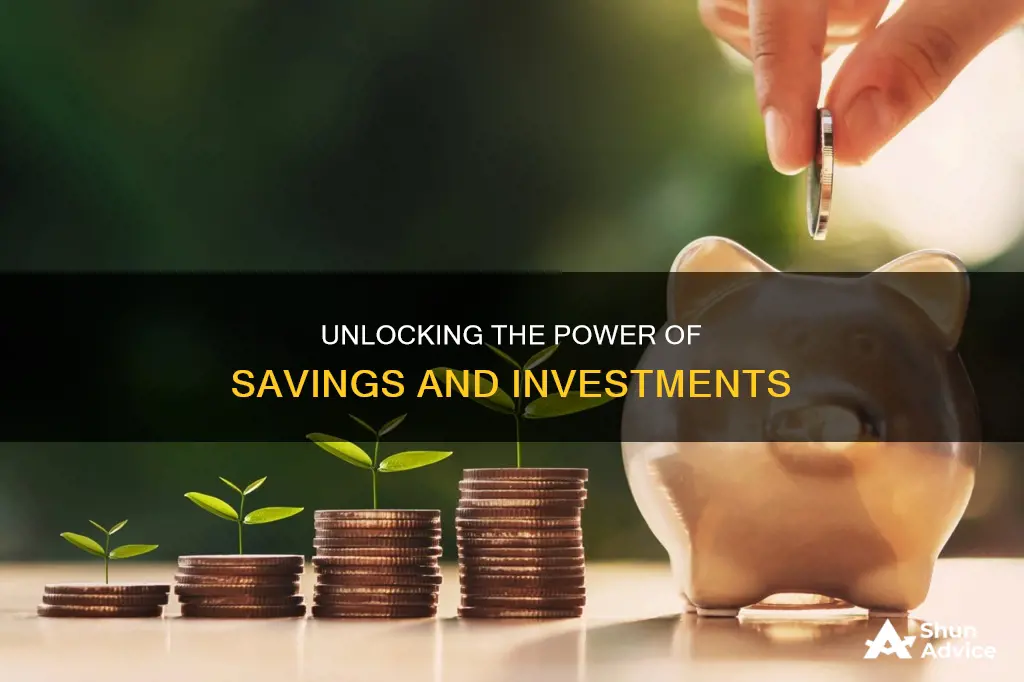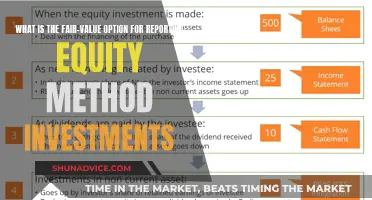
Investing is one of the best ways to see solid returns on your money. There are many options available in today's high-tech financial world, from savings accounts to stocks, bonds, and funds.
Before you start investing, it's important to determine your budget and risk tolerance, and to understand the different types of investments available to you.
If you're just starting out, a savings account is a safe space for holding money and a perfect way to start preparing for your financial future. You can open a savings account at a bank or credit union, and the account may come with restrictions on the number of withdrawals you can make. Some savings accounts, like high-yield savings accounts, offer more attractive interest rates than standard savings accounts.
If you're looking to invest in the stock market, you'll need to decide whether you want to be an active or passive investor. Active investing requires researching and constructing your portfolio yourself, while passive investing involves putting your money in investment vehicles where someone else does the hard work, like mutual funds.
You can also invest in bonds, which are a low-risk investment issued by governments or companies.
Robo-advisors are another option, where an algorithm constructs and maintains a portfolio for you based on your risk tolerance and financial goals.
There are many ways to invest your money, and the best approach will depend on your financial situation, goals, and risk tolerance.
| Characteristics | Values |
|---|---|
| What to invest in | Stocks, bonds, mutual funds, exchange-traded funds (ETFs), certificates of deposit (CDs), savings accounts |
| Investment goals | Short-term, medium-term, long-term |
| Investment account | Taxable brokerage account, tax-advantaged account (IRA), high-yield savings account |
| Investment strategy | Active investing, passive investing |
| Amount to invest | No set amount to start investing, but consider emergency fund and getting rid of high-interest debt |
What You'll Learn

How to open a high-yield savings account
Opening a high-yield savings account is a great way to grow your savings faster. Here's a step-by-step guide on how to open one:
Step 1: Research and Compare Options
Before opening an account, it's important to do your research and compare different high-yield savings accounts. Look for accounts with competitive interest rates, low fees, and features that meet your needs. Consider both online banks and traditional brick-and-mortar institutions. Online banks often offer higher interest rates due to lower overhead costs.
Step 2: Choose the Right Institution
After researching, choose an institution that best suits your requirements. Consider factors such as interest rates, fees, minimum balance requirements, and account features. You may also want to check if the institution is FDIC-insured, which provides protection for your deposits.
Step 3: Complete the Account Application
Once you've selected the institution, fill out the account application. This can usually be done online and typically requires providing personal information such as your name, contact details, Social Security number, and government-issued photo ID. You'll also need to decide whether to open the account as an individual or jointly with another person.
Step 4: Fund Your Account
After your application is approved, it's time to fund your new account. You may be required to set up an electronic transfer from an external account or deposit funds through other means, such as mobile check deposit or wire transfer. Some institutions may have minimum initial deposit requirements, while others may not.
Step 5: Enroll in Online Banking
Enrolling in online banking will allow you to manage your account conveniently. Most banks will provide instructions on how to set up online access, and you may be able to download their mobile app to access your account on the go.
Step 6: Set Up Beneficiaries
Designating beneficiaries is an important step in the account setup process. Beneficiaries are individuals you name to inherit your account balance in the event of your death. Most accounts allow you to establish primary and secondary beneficiaries.
Step 7: Customize Your Account Settings
Customize your account settings to suit your preferences. This includes turning on alerts for account activity, such as deposits or withdrawals above a certain amount. You can also choose to receive electronic statements (e-statements) instead of paper statements for added security and convenience.
Step 8: Link Additional Accounts
If you frequently transfer funds between accounts, consider linking your new high-yield savings account to your other accounts. This will make it easier to manage your finances and transfer funds when needed.
Step 9: Understand the Account Rules
Finally, take the time to understand all the rules and requirements of your new account. Some accounts may have specific guidelines to avoid monthly fees or earn the highest interest rates. By following these rules, you can maximize your savings and avoid any unexpected charges.
Investing Life Savings: Strategies for Long-Term Financial Growth
You may want to see also

How to open a savings account for a child
Opening a savings account for your child can be a great way to introduce them to the world of finance and help them develop good money habits. Here are the steps you can follow to open a savings account for your child:
Choose the type of account:
There are two main types of accounts you can open for your child: a standard savings account or a custodial account. A standard savings account will give your child joint ownership of the account and allow them to access the funds. On the other hand, a custodial account, also known as a Uniform Gifts to Minors Act (UGMA) or Uniform Transfers to Minors Act (UTMA) account, treats the money as a gift owned by your child, but you retain control of the account until they turn 18.
Determine your goals:
Think about why you want your child to have a savings account. Do you want to teach them about money management, banking, or saving for a specific goal? Discuss this with your child and use their questions and interests to guide your choice of account and financial institution.
Compare different banks and credit unions:
Look for accounts with competitive interest rates, no monthly fees, low or no opening balance requirements, and educational resources for your child. Some accounts also offer features like mobile apps, financial literacy tools, and the ability to create multiple savings goals.
Gather the required documents:
To open a savings account for your child, you will typically need to provide information such as your child's name, birthdate, and Social Security number. You may also need to provide your own identification, such as a driver's license or passport, as well as your Social Security number and contact information.
Visit a branch or open an account online:
Most banks and credit unions will allow you to open a savings account for your child in person at a branch or through their website. If your child is old enough, consider taking them with you to the branch to make it a fun and educational experience.
Make an initial deposit:
Some banks require a minimum opening deposit, while others don't. You can usually make the initial deposit in person or via an electronic transfer from another bank account.
By following these steps, you can help your child develop financial literacy and set them on a path towards a secure financial future.
Maximizing Small Savings: Smart Strategies for Investing Wisely
You may want to see also

How to decide between active and passive investing
When deciding between active and passive investing, it is important to consider your financial goals, risk appetite, and the time you can dedicate to monitoring and managing your investments. Both strategies have their own advantages and disadvantages, and the right choice depends on your personal preferences and investment objectives.
Active investing involves closely managing a portfolio to take advantage of market fluctuations. Active investors keep a constant eye on their portfolio, buying and selling assets with the goal of beating the market. This approach requires a hands-on, active participant, such as a portfolio manager, or the investor themselves if they feel confident enough. It requires a deep analysis of the market and the expertise to know when to pivot in or out of a particular stock, bond, or asset. Active investing can result in faster, short-term, above-market profits, but it also comes with higher fees and a greater appetite for risk.
On the other hand, passive investing takes a more relaxed, long-term approach. Passive investors typically hold onto their investments for longer, employing a 'buy-and-hold' strategy, and aim to make steady returns that match market movements. They tend to purchase index funds or mutual funds and allow their wealth to grow alongside the market. This strategy is less reactive to market changes and often results in lower fees. However, passive funds may be more vulnerable to downturns and can have smaller short-term returns.
Passive investing is often favoured due to its low fees, transparency, and tax efficiency. Active investing, on the other hand, offers more flexibility and the potential for higher returns, but it also comes with higher costs and the risk of underperforming the market.
Ultimately, the choice between active and passive investing depends on your personal preferences, investment goals, and risk tolerance. You can also choose to blend both strategies to take advantage of the strengths of each, minimising risk and maximising returns.
Invest Your Savings Wisely: A Guide for Nigerians
You may want to see also

How to choose a savings account
When choosing a savings account, it's important to consider your financial goals and needs. Here are some factors to keep in mind when making your decision:
Interest Rates
One of the most important factors to consider when choosing a savings account is the interest rate offered. Look for accounts with competitive interest rates, also known as annual percentage yields (APYs). The higher the APY, the faster your savings will grow. However, keep in mind that some accounts with higher interest rates may have more restrictions or requirements.
Accessibility
Consider how easily you'll be able to access your money. Some savings accounts may have restrictions on withdrawals, such as a limited number of transactions per month. Others may be online-only, without branch banking access. Choose an account that offers the level of accessibility you need.
Fees
Be mindful of any fees associated with the savings account. Some accounts may charge monthly maintenance fees, excess transaction fees, or other charges. Look for accounts with low or no fees to maximize your savings.
Minimum Deposit and Balance Requirements
Some savings accounts require a minimum deposit to open the account or maintain a minimum balance to earn the advertised interest rate. Make sure you can meet these requirements before choosing an account.
Linked Accounts
Certain savings accounts may require you to open a linked transaction account at the same bank. This could be convenient if you want all your accounts in one place, but be aware of any additional fees or requirements associated with the linked account.
Safety and Insurance
Ensure that your savings are protected by choosing a savings account that is insured by a reputable institution. In the US, look for accounts insured by the Federal Deposit Insurance Corporation (FDIC) or the National Credit Union Administration (NCUA), which typically cover deposits up to $250,000.
Other Financial Products
Consider the other financial products offered by the bank or credit union. If you're looking for a one-stop shop, choose an institution that offers checking accounts, loans, or investment options in addition to savings accounts.
Special Features
Some savings accounts offer special features such as ATM access, overdraft protection, or money management tools. Choose an account that offers the features you need to help you reach your financial goals.
Remember, there is no one-size-fits-all savings account. Evaluate your financial situation and goals, compare different savings accounts, and select the one that best aligns with your needs. You can also consider opening multiple savings accounts to achieve different financial objectives.
Invest Your Savings: Safe Strategies for Beginners
You may want to see also

How to invest in stocks
Investing in stocks means buying shares of ownership in a public company. If the stock you own becomes more valuable, you could earn a profit if you decide to sell it to another investor. Most people invest in stocks online, through a brokerage account. You can also purchase funds, which hold many different stocks within one investment.
- Decide if you want to invest on your own or with help: You can choose to practice investing with fake money until you get the hang of it, or you can opt to select stocks and stock funds on your own. If you don't care about picking investments, you can also get help from a robo-advisor, a service that invests your money for you for a small fee.
- Choose a broker or robo-advisor: If you're investing on your own, you'll need to pick a broker to open an account with. Evaluate brokers based on factors such as costs, investment selection, investor research, tools, and customer service access. If you're investing through a robo-advisor, compare different advisors to find one that offers the services you need.
- Pick a type of investment account: There are several types of investment accounts, such as a standard brokerage account or a Roth IRA, which has significant tax benefits. Consider your personal financial situation and goals when choosing an account type.
- Learn the difference between investing in stocks and funds: For most people, stock market investing means choosing between investing in individual stocks or stock mutual funds/exchange-traded funds (ETFs). Mutual funds and ETFs allow you to purchase small pieces of many different stocks in a single transaction, providing diversification and reducing risk.
- Set a budget for your stock market investment: Determine how much money you want to invest, keeping in mind that individual stocks have different share prices, and mutual funds often have minimum investment requirements. As a general rule, it's recommended to allocate a large portion of your portfolio towards stock funds, especially if you have a long-term investment horizon.
- Focus on investing for the long term: Stock market investments are typically a good way to grow your wealth over the long term. While there will be fluctuations in the market, historical data shows that the average stock market return is about 10% per year.
- Manage your stock portfolio: Regularly review your portfolio to ensure it aligns with your investment goals. Consider factors such as your risk tolerance, investment horizon, and the performance of individual stocks or funds.
Equity Linked Savings Schemes: A Smart Investment Guide
You may want to see also
Frequently asked questions
To open a savings account, you must submit an application. You will need to provide a government-issued ID, such as a driver's license or passport, and your Social Security number. You can then choose whether to open a single or joint account and prepare your initial deposit. Finally, submit your application for review and approval by the bank.
Financial institutions typically offer standard savings accounts, high-yield savings accounts, money market accounts, and certificates of deposit. Each type of account has different features, interest rates, restrictions, and benefits.
When picking a savings account, consider your end goal and the type of account that would be most suitable for your money and lifestyle. Think about whether you want to be able to spend from your savings or let your deposits accrue interest. Other factors to consider include the interest rate, minimum balance requirement, fees, accessibility of the institution, and tax benefits.
Before starting to invest, determine your investing style, set an investing budget, and analyze your risk tolerance. Identify whether you prefer active or passive investing, decide on your budget, and assess how much financial risk you are willing to take.







